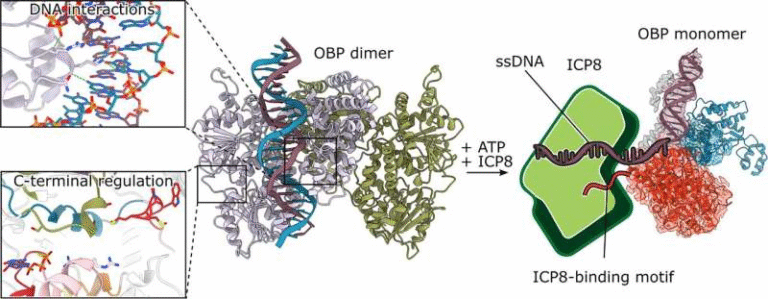Scientists Discover the Genetic Trick Behind Ants’ Super Sense of Smell

Ants have long been admired for their complex societies and extraordinary communication skills. Now, scientists have uncovered the hidden genetic mechanism that gives these tiny insects their remarkably sharp sense of smell—a discovery that not only explains how ants keep their chemical messages crystal clear but also reveals a new form of gene regulation in nature.
Researchers from the Rockefeller University, led by Daniel Kronauer and his team, have published their groundbreaking study in Current Biology (September 2025). Their work focuses on the clonal raider ant (Ooceraea biroi), a species that has become a powerful model for understanding social insect genetics. What they found solves a long-standing mystery: how each ant’s smell neuron activates just one odorant receptor gene while keeping hundreds of others silent.
This simple but elegant “one receptor, one neuron” rule is what allows ants to smell the world with precision, avoiding confusion in the dense chemical environment of their colonies.
Ant Societies: Built on the Language of Scent
Ants live in societies that are almost entirely organized through chemical communication. Their survival and cooperation depend on their ability to detect, interpret, and respond to a vast range of smells. Pheromones—the chemical signals they release—help them find food, warn others of threats, recognize nestmates, and even coordinate tasks like brood care or defense.
Every one of these signals must be processed accurately. Inside an ant’s antennae are thousands of olfactory sensory neurons (OSNs), each designed to detect one specific scent. To maintain clarity, each neuron must activate only one odorant receptor (OR) gene from the hundreds available in the ant genome. If a neuron were to express multiple receptors, the signals would blend and become meaningless noise, ruining the ant’s precise communication system.
For decades, scientists knew this “one receptor per neuron” rule existed, but how ants actually pulled it off—given their massive number of receptor genes—was unknown.
The Challenge: A Crowded Genetic Neighborhood
Unlike fruit flies, which have about 60 receptor genes, ants have hundreds, many arranged in tight clusters of nearly identical DNA sequences. This genomic crowding poses a major problem: when one gene turns on, nearby genes can easily be triggered too.
In fruit flies, molecular switches turn each receptor gene on or off with pinpoint accuracy. In mammals, the process is more random—neurons shuffle and reorganize their chromatin (the DNA packaging material) until only one receptor gene remains active.
But ants are different. Their gene clusters are so dense that neither of these known systems could explain how they achieve such clean, selective expression. The clonal raider ant, with its well-mapped genome and ability to reproduce clonally in the lab, provided the perfect model for solving this puzzle.
How the Scientists Solved It
The Kronauer Lab built upon their earlier 2023 paper, which had hinted that when ants express one odorant receptor, the RNA from that gene stays active while others are silenced. In their new work, the researchers wanted to catch this process in the act.
They dissected the antennal tissue of clonal raider ants and used RNA sequencing to identify which genes were turned on in each neuron. They combined this with RNA fluorescence in situ hybridization (RNA-FISH), a powerful imaging method that reveals where specific RNA molecules are located inside cells.
These techniques allowed them to visualize a single receptor gene lighting up in a neuron while its neighboring genes stayed dark. Then, they looked deeper—into the molecular behavior of RNA polymerase, the enzyme responsible for reading DNA and copying it into RNA.
The Hidden Mechanism: Transcriptional Interference
Here’s what they found: when a neuron chooses one odorant receptor gene, RNA polymerase doesn’t stop neatly at the end of that gene. Instead, it keeps moving—“reading through” into the DNA regions downstream. This extra, non-functional RNA doesn’t leave the nucleus, but its mere presence prevents nearby genes from activating.
At the same time, the polymerase works in the opposite direction too. It generates antisense RNA transcripts—RNA copies that run the other way along the DNA strand. These act as roadblocks, silencing the genes upstream of the chosen receptor.
The result is what the researchers call a protective genetic shield: the chosen receptor gene stands out as the only active one, while all its neighbors are effectively muted on both sides.
This double-layered control mechanism is known as transcriptional interference. It ensures that each olfactory neuron in the ant’s antenna produces only one receptor type, preserving the high-fidelity communication system ants rely on.
Why This Is a Big Deal
This discovery doesn’t just explain how ants smell—it also reveals a new type of gene regulation that could exist across many species. By using transcriptional interference to silence neighboring genes, ants show how nature can handle the problem of managing large, repetitive gene families efficiently.
The team also found that this mechanism isn’t unique to clonal raider ants. It appears to be active in other social insects like the Indian jumping ant and the honeybee. That suggests transcriptional interference may be a widespread evolutionary solution among insects with complex olfactory systems.
Interestingly, this mechanism might make it easier for ants to evolve new receptors. When new odorant receptor genes appear through duplication—a common evolutionary event—they can easily be incorporated into the system without disrupting the existing setup. The interference process automatically keeps everything balanced, allowing ants to expand their sense of smell rapidly over evolutionary time.
As Daniel Kronauer notes, once such a system is in place, it can handle increasing complexity without breaking down. That adaptability could explain why ants have become such chemically sophisticated creatures.
Beyond Ants: What This Means for Biology
The implications stretch beyond ant biology. Many organisms contain large gene families—groups of similar genes that need to be selectively activated. Understanding how ants manage this at the transcriptional level may help researchers uncover similar mechanisms in other systems, including in humans.
For example, the human immune system also relies on precise gene activation to ensure that each immune cell produces a unique antibody or receptor. Discovering that transcriptional interference can act as a “gatekeeper” might help biologists understand or even manipulate such systems in medical research.
It also adds a new chapter to the general understanding of how genomes regulate themselves. Instead of relying solely on switches or random gene selection, cells might sometimes use directional RNA interference to carve out zones of activity and silence in dense genomic regions.
Understanding the Ant Nose
To appreciate how powerful this mechanism is, it helps to know a bit about how ants actually smell. Ant antennae are covered in sensory hairs (sensilla), each containing several neurons. Every neuron connects to the brain’s antennal lobe, a structure similar to the olfactory bulb in mammals.
When an odor molecule binds to a receptor on the surface of a neuron, it triggers an electrical signal that travels to a specific part of the antennal lobe. Each type of receptor connects to its own glomerulus—a neural hub that processes information about that particular scent.
This means that each odorant receptor acts like a key to one lock, sending a clean signal that the brain can interpret precisely. By maintaining strict “one receptor, one neuron” control, ants can distinguish hundreds of chemical cues that form the basis of their pheromone language.
Without this precision, ants would lose their ability to coordinate complex colony behaviors such as trail following, queen recognition, or alarm signaling.
How This Compares to Other Species
The principle of one receptor per neuron is not unique to ants—it’s seen in mammals and flies too—but the way it’s achieved differs drastically.
- Fruit flies use tightly controlled molecular switches to turn on one gene and turn off others. Their smaller number of receptor genes makes this approach feasible.
- Mammals, including humans, use a random process. Each neuron starts with multiple potential receptor genes, but through a trial-and-error mechanism, only one remains active while others are silenced by chromatin reorganization.
- Ants, on the other hand, manage hundreds of similar genes crammed together. Their transcriptional interference system allows them to maintain order in what would otherwise be genetic chaos.
This finding also suggests that fruit flies may be the exception, not the rule, when it comes to olfactory regulation. The mechanism discovered in ants might represent the standard strategy for many insects with large receptor families.
What’s Next for Researchers
The Kronauer team’s discovery answers one major question but opens several new ones. How do neurons decide which receptor gene to activate in the first place? Is it random, or does some unknown molecular cue guide the selection?
Future studies may also look into whether this interference mechanism plays roles in other parts of the genome, or in non-olfactory systems where similar gene clusters exist. There’s also curiosity about whether insects that rely less on smell, such as solitary wasps or beetles, use the same trick—or whether they’ve evolved different strategies altogether.
Regardless, this study represents a milestone in molecular biology and neurogenetics. It shows that even in a creature as small as an ant, the rules of gene expression can be remarkably sophisticated—and that evolution continually finds clever ways to make complex systems work smoothly.
Reference
Research Paper: Transcriptional interference gates monogenic odorant receptor expression in ants – Current Biology (2025)





